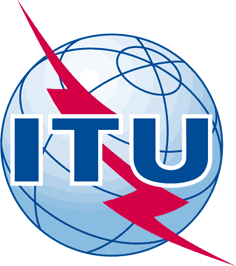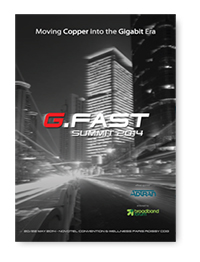| |
|
|
|
| |
|
WEDNESDAY 21 MAY 2014 | CONFERENCE DAY ONE |
|
| |
|
|
|
| |
|
|
|
| |
official sponsors
 |
| |
 |
| |
| |
endorsed by
 |
| |
 |
| |
| |
| |
| |
| |
| |
| |
download the brochure pdf
 |
| |
|
|
07.45 |
WELCOME, REGISTRATION AND COFFEE |
|
| |
 |
 |
CHAIRMAN
Teun van der Veen
Senior consultant Network Technology, TNO |
|
| |
|
|
| |
|
|
| |
Introduction/Standardization Progress/Regulation |
| |
|
| |
|
|
| |
08.30 |
 |
Keynote by Thomas Starr
Broadband Forum, AT&T
Presenting FTTdp with G.fast, VDSL2, and Vectored VDSL2, the BBF’s equipment testing programs for G.fast and Vectored VDSL2, and management of alien crosstalk with Vectored VDSL2. |
|
|
| |
|
|
| |
|
|
| |
09.00 |
Overview of G.fast |
|
| |
|
 |
Discussing the origins of the proposal in BBF, the development timeline of the standard to date, the technical challenges faced, the controversial issues resolved, the main technical aspects of the standard and the current status.
Frank Van Der Putten
Rapporteur for the ITU-T SG15 Q4 |
|
|
| |
|
|
|
| |
Deployments and Business Cases |
| |
|
| |
|
| |
10.00 |
BT: Report from a G.fast Trial |
|
| |
|
 |
In October 2013, BT and Huawei deployed a multiport G.Fast prototype unit into the BT network at a distribution point (DP) location. Three triallists were then connected to the G.Fast DPU and onwards to the internet via 10G backhaul. This presentation shares some of the results and findings from this trial.
Trevor Linney, BT |
|
|
| |
|
|
|
| |
10.30 |
Swissom’s Path to G.fast |
|
| |
|
 |
With the FTTS (Fiber To The Street, which is the Swisscom term for FTTdp) and FTTB concepts Swisscom is today deploying smaller VDSL2 based DSLAMs closer to the customer. This presentations describes the current deployment and the evolution towards G.fast.
Oliver Lamparter
Swisscom |
|
|
| |
|
|
|
| |
11.00 |
COFFEE BREAK |
| |
|
|
|
| |
11.30 |
Exploring the Challenges and Opportunities in Deploying G.fast |
|
| |
|
 |
Carrier motivations for migrating to FTTDp with G.fast as an interim step towards FTTH.
Upgrade scenarios for upgrading from FTTN with VDSL2 to FTTDp with G.fast.
Dr. Debajyoti Pal
CTO, Ikanos |
|
|
| |
|
|
|
| |
12.00 |
Geographic Deployment and Cost studies for G.fast – Hybrid versus
Full FTTH |
| |
|
 |
Describing a geographic scenario study of the deployment feasibilities of Hybrid FTTH with G.fast. The study itself details to a particular case of the Netherlands (dedicated to Amsterdam and Den Haag), but the conclusions may roughly hold for any dense city area elsewhere in the world.
Rob van den Brink, TNO |
|
|
| |
|
|
|
| |
12.30 |
LUNCH |
|
| |
|
|
|
| |
14.00 |
End-to-end Architecture for G.fast Networks |
| |
|
 |
Analyzing trends in next-generation access and home networks, and how they will be affected by the widespread deployment of new technologies such as G.fast. Discussing best practices and system architectures for integrating G.fast with other broadband technologies such as PON, Wi-Fi, G.hn, Carrier Ethernet, and IPTV.
Chano Gómez, Marketing Manager for Broadband Access and Home Networking Solutions, Marvell Semiconductor |
|
| |
|
|
| |
|
|
|
| |
System Technologies, Implementations and Architecture for G.fast |
|
| |
|
| |
|
|
|
| |
14.30 |
How to Deliver Gigabit Broadband |
|
| |
|
 |
Enabling a software-based architecture for Wi-Fi access point coordination and resource sharing can lead to effective speeds of over 1 Gbps per household. This dramatic broadband service transformation requires no new standards, no new hardware, and no large construction efforts. It can be realized by using existing mass-deployed technologies and by fully extending the concepts of network virtualization all the way to the access segment and the home network.
Dr. John Cioffi and Dr. George Ginis, ASSIA |
|
|
| |
|
|
|
| |
15.00 |
Key Factors besides the Standard to make G.fast a Successful Technology |
|
| |
|
 |
Discussing the challenges with the new Fiber To The Distribution Point (FTTDP) scenarios based on the field experience with Outside Plant DSLAMs and derive key factors besides the standard tool box which makes G.fast products an important part in the access network mixture.
Uwe Schmidtke, Adtran |
|
|
| |
|
|
|
| |
15.30 |
Facilitating Fiber Level Quality over Copper with a Traffic Adaptive Technology |
|
| |
|
 |
Fiber level quality over copper is now feasible. On the other hand, efficiency is not sacrificed. The higher performing modem can be implemented in an efficient manner, adapting its power consumption to the varying traffic needs. Combining both optimizations, minimizing the power consumption while maximizing performance is a major challenge in the success of the G.fast technology.
Rami Verbin, Sckipio |
|
|
| |
|
|
|
| |
16.00 |
Implementation Complexity along the Evolution from VDSL2 to G.fast |
| |
|
 |
Sheding light on major building blocks of the DSL and G.fast transceivers with respect to complexity and technological challenges. In consideration of current and upcoming silicon technology nodes, the complexity challenges of G.fast are revisited and compared to the historic development of VDSL2.
Rudi Frenzel, Lantiq |
|
|
| |
|
|
|
| |
16.30 |
COFFEE BREAK |
|
| |
|
|
|
| |
Panel/Debate |
|
| |
|
|
| |
17.00 |
FTTH/VDSL2/ G.fast: Overlaping or Complementarity? |
| |
|
MODERATOR
Teun van der Veen
Senior consultant Network Technology, TNO |
| |
|
|
| |
|
PARTICIPANTS
Thomas Starr, Broadband Forum, AT&T
Rami Verbin, Sckipio
Rob van den Brink, TNO
Dr. Debajyoti Pal, Ikanos
Oliver Lamparter, Swisscom
|
| |
|
|
|
| |
| |
|
|
|
| |
18.00 |
END OF THE CONFERENCE DAY ONE WELCOME COCKTAIL |
|
| |
|
|
|
|
| |
|
|
|
|